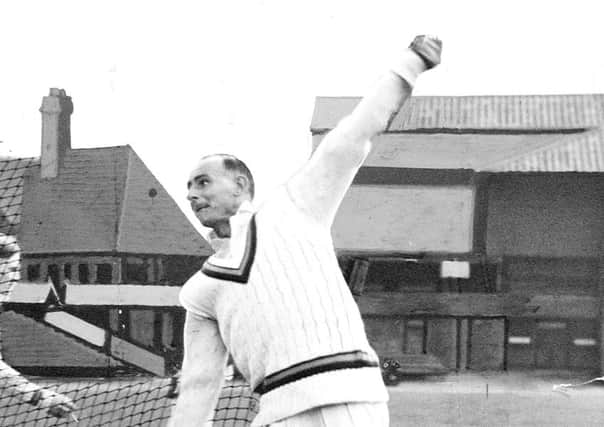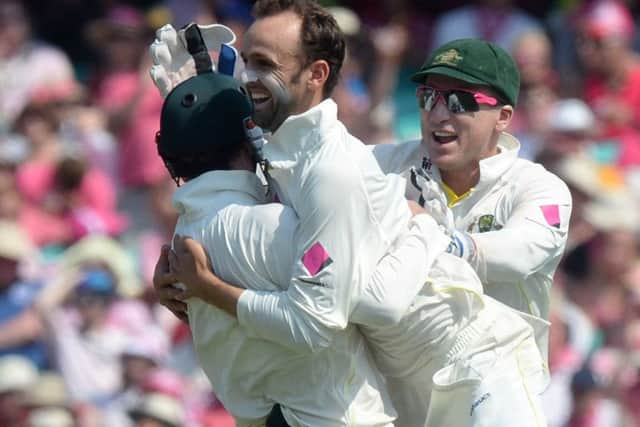Bygones: Howzat for a record as Viljoen follows in tradition of Macaulay


Considering that nearly 3,000 people have played Test cricket since the format was born in 1877, it puts his feat into some kind of perspective.
Viljoen joined a select group that includes Bradford-born left-arm spinner Richard Illingworth, who did not play for Yorkshire but represented Worcestershire, and who captured a wicket with his first ball in Test cricket when he bowled West Indies opener Phil Simmons at Trent Bridge in 1991.
Advertisement
Hide AdAdvertisement
Hide AdIt also features a man who did play for the White Rose county – George Macaulay, one of the finest off-spin bowlers of the inter-war period.


A quick glance at the records shows just what a magnificent bowler Macaulay was, even if his name today is largely forgotten outside of his native Thirsk.
In 445 first-class games for Yorkshire between 1920 and 1935, Macaulay took 1,774 wickets at 17.22.
Just Wilfred Rhodes, George Hirst and Schofield Haigh have claimed more for the club, with Macaulay’s record almost identical to that of Fred Trueman, who took 1,745 wickets at 17.12.
Advertisement
Hide AdAdvertisement
Hide AdHad it not been for his famous contemporary Hedley Verity, the Yorkshire and England left-arm spinner, Macaulay’s record might have been even more impressive and he may have made more than eight Test appearances, which were stretched out over a 10-year period.


It was at Cape Town in 1923 that Macaulay made his debut against South Africa in one of the most thrilling Tests ever played.
England’s one-wicket win was sealed when Macaulay, batting at No 11, hit the winning run off Alf Hall, a Bolton-born left-arm pace bowler who was also making his debut.
The Daily Telegraph wrote: “The fieldsmen closed in on the batsmen in a last desperate effort to stop the winning run, and Hall completely beat Macaulay with his second delivery.
Advertisement
Hide AdAdvertisement
Hide Ad“But the next ball the Yorkshireman got away for a single, and England had won.”
The paper said that Macaulay and Alex Kennedy, the other not out batsman, were “loudly cheered at the close, while Alf Hall, who by his wonderful bowling (11-112) almost won the match for his side, was chaired off the field in triumph”.
It is one of just 12 times that a team has won a Test match by one wicket, half of which have occurred since 1994.
Macaulay, who began life as a quick bowler before reducing his pace on the advice of Hirst and Rhodes, gained selection for the South Africa tour after finishing leading wicket-taker in Yorkshire’s Championship-winning season of 1922.
Advertisement
Hide AdAdvertisement
Hide AdIt was the first of four successive titles for the club, a period in which no-one bettered Macaulay’s tally of 604 wickets at 13.
English cricket, however, was rather in the doldrums, still recovering from the Great War in which Macaulay had served in the Royal Field Artillery.
In the two Test series played since the start of that conflict, England had suffered thumping defeats to Australia –5-0 Down Under in 1920-21 and 3-0 at home in 1921.
In those days, not every cricketer toured when the chance arose, often because of business interests.
Advertisement
Hide AdAdvertisement
Hide AdJack Hobbs, the legendary Surrey opening batsman, was among those who declined the MCC’s invitation to tour South Africa, which prompted Wisden to say that the England team “could not be described as representative”.
Indeed, five England players made their own Test debuts in the opening fixture in Johannesburg.
Arthur Carr, Arthur Gilligan, Alex Kennedy, Greville Stevens and even captain Frank Mann all appeared for the first time, experiencing a baptism of fire as South Africa won by 168 runs.
The second Test in Cape Town began on New Year’s Day, 1923, and Macaulay opened the bowling on his debut after South Africa won the toss.
Advertisement
Hide AdAdvertisement
Hide AdThe 25-year-old struck before a run had been scored, George Hearne caught in the slips by Percy Fender, who led England’s bowling effort with 4-29.
Later in the innings, Macaulay had Norwegian-born tail-ender Buster Nupen caught-and-bowled, returning 2-19 from 13 overs with five maidens as the hosts totalled 113.
Macaulay hit 19 from the No 11 position as England replied with 183, and he then dragged them back into the match after South Africa reached a threatening 157-1 in their second innings.
Macaulay took 5-64 from 37 overs with 11 maidens as the hosts were dismissed for 242, which left England needing 173 for victory.
Advertisement
Hide AdAdvertisement
Hide AdIt was a tricky target, and Wisden noted that “things looked very bad indeed when, at the end of the afternoon, the score stood at 86 with six wickets down”.
The following day, Mann and Vallance Jupp added 68 for the seventh-wicket, and when Macaulay strode out, five runs were still wanted.
Kennedy struck a leg-side four before Macaulay’s winning run, England going on to take the series 2-1 following draws in Durban and Johannesburg as they clinched the last Test in Durban by 109 runs.
Macaulay – England’s second-highest wicket-taker in the series with 16 at 20.37 – never again enjoyed an extended run in the national side.
Advertisement
Hide AdAdvertisement
Hide AdHe played one Test against South Africa at Headingley the following year, another against Australia at Headingley in 1926, and two against the West Indies in 1933 at Lord’s and Old Trafford.
Instead, it was in Yorkshire colours that Macaulay excelled, winning eight Championships with the club before a hand injury forced his retirement.
As well as a very great cricketer, Macaulay was also a very great character.
He had a sharp wit and could be very charming, but he was also fiercely competitive and prone to calling a spade a spade.
Advertisement
Hide AdAdvertisement
Hide Ad“Antagonism personified,” was JM Kilburn’s verdict, with Macaulay possessing a fast bowler’s temperament.
“He knew all the dodges,” wrote his Yorkshire team-mate Bill Bowes. “He glared at batsmen, thought nothing of bowling a fast ’un straight at the head, and, pouncing on the ball, as lithe as a panther, could hurl it back at the wicket, fast and true. There was ‘devil’ in everything he did.”
Macaulay, who died of pneumonia in 1940 while on active service in the RAF, aged 43, was an enigmatic man.
“Like many others, I never knew Macaulay thoroughly even after years of playing alongside him,” added Bowes.
Advertisement
Hide AdAdvertisement
Hide AdBut Macaulay’s name endures, and thanks to his feat in taking a wicket with his first ball at Cape Town in 1923, it is in the Test match record books for eternity.
Horan set ball rolling after 10-match wait
THE first man to take a wicket with his first ball in Test cricket was Tom Horan, an Irish-born batsman and occasional bowler who played for Australia against England in the very first Test match at Melbourne in 1877.
Horan, who was brought to Melbourne when he was a small boy, did not actually perform the feat in that game but on the 10th of his 15 Test appearances against England at Sydney in 1883.
He bowled the Surrey batsman Walter Read on his way to figures of 3-22 in a match which England won by 69 runs.
Advertisement
Hide AdAdvertisement
Hide AdAlong with Yorkshire spin bowler George Macaulay, Richard Illingworth and Hardus Viljoen, mentioned in the main piece opposite, the others to have taken a wicket with their first ball in Tests are as follows:
Arthur Coningham (Australia), Bill Bradley (England), Ted Arnold (England), Bert Vogler (South Africa), Jack Crawford (England), Maurice Tate (England), Matt Henderson (New Zealand), Dennis Smith (New Zealand), Tyrell Johnson (West Indies), Dick Howorth (England), Intikhab Alam (Pakistan), Nilesh Kulkarni (India), Chamila Gamage (Sri Lanka), Nathan Lyon (Australia), Shaminda Eranga (Sri Lanka) and Dane Piedt (South Africa).